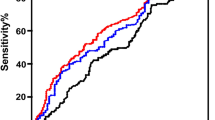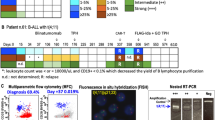Abstract
The fusion gene AML1/ETO is a molecular marker for monitoring minimal residual disease (MRD) in acute myeloid leukemia with the t(8;21)(q22;q22) translocation. To evaluate the dynamic variation and prognostic significance of AML1/ETO, bone marrow samples from 52 patients at different periods were examined qualitatively (32 patients) or quantitatively (20 patients) using nested RT-PCR and RQ-PCR, respectively. In the qualitative group, AML1/ETO in 71.88 and 95.45 % patients became negative at six and 24 months after CR, respectively. Patients in long-term remission were all RT-PCR-negative. Patients negative for AML1/ETO at 6–12 months and 12–18 months after CR had lower relapse rate (P = 0.003 and 0.000), higher relapse-free survival (RFS) (P = 0.000 and 0.000), and overall survival (P = 0.001 and 0.000) than patients with positive AML1/ETO. Quantitative analysis showed that there was no trend where higher relapse rate occurred in patients with higher levels of AML1/ETO transcripts at diagnosis (P > 0.05). Patients whose AML1/ETO transcripts decreased by more than 2 log at CR had higher RFS (P = 0.02). At the checkpoints of 3 and 5/6 months after CR, patients with lower AML1/ETO copy numbers showed lower probability of relapse (P = 0.039 and 0.004). An increase of AML1/ETO transcripts (0.5 log) at any time after CR indicated increased risk of relapse (P = 0.002). Our study shows that both qualitative and quantitative detection of AML1/ETO have prognostic value in MRD monitoring. Negative or continuous low expression of AML1/ETO indicates increased disease-free survival.






Similar content being viewed by others
References
Byrd JC, Mrózek K, Dodge RK, et al. Pretreatment cytogenetic abnormalities are predictive of induction success, cumulative incidence of relapse, and overall survival in adult patients with de novo acute myeloid leukemia: results from Cancer and Leukemia Group B (CALGB 8461). Blood. 2002;100:4325–36.
Downing JR, Head DR, Curcio-Brint AM, et al. An AML1/ETO fusion transcript is consistently detected by RNA-based polymerase chain reaction in acute myelogenous leukemia containing the t(8;21)(q22;q22) translocation. Blood. 1993;81:2860.
Nucifora G, Larson RA, Rowley JD, et al. Persistence of the (8;21) translocation in patients with acute myeloid leukemia type M2 in long-term remission. Blood. 1993;82:712–5.
Kusec R, Laczika K, Knöbl P, et al. AML1/ETO fusion mRNA can be detected in remission blood samples of all patients with t(8;21) acute myeloid leukemia after chemotherapy or autologous bone marrow transplantation. Leukemia. 1994;8:735–9.
Miyamoto T, Nagafuji K, Akashi K, et al. Persistence of multipotent progenitors expressing AML1/ETO transcripts in long-term remission patients with (8;21) acute myelogenous leukemia. Blood. 1996;87:4789–96.
Jurlander J, Caligiuri MA, Ruutu T, et al. Persistence of the AML1/ETO fusion transcript in patients treated with allogeneic bone marrow transplantation for t(8;21) leukemia. Blood. 1996;88:2183–91.
Gabert J, Beillard E, van der Velden VH, et al. Standardization and quality control studies of ‘real-time’ quantitative reverse transcriptase polymerase chain reaction of fusion gene transcripts for residual disease detection in leukemia—a Europe Against Cancer program. Leukemia. 2003;17:2318–57.
Mi Y, Xue Y, Yu W, et al. Therapeutic experience of adult acute myeloid leukemia in a single institution of China and its relationship with chromosome karyotype. Leuk Lymphoma. 2008;49(3):524–50.
Liu J, Mi Y, Yu W, et al. Intensive induction chemotherapy with regimen containing intermediate dose cytarabine in the treatment of de novo acute myeloid leukemia. Am J Hematol. 2009;84(7):422–7.
Li W, Mi YC, Liu BC, et al. Clinical and cytogenetic features and their influencing factors of core binding factor acute myeloid leukemia. Zhongguo Yixue Ke Xue Yuan Xue Bao. 2011;33(5):517–24.
Satake N, Maseki N, Kozu T, et al. Disappearance of AML1/MTG8 (ETO) fusion transcript in acute myeloid leukaemia patients with t(8;21) in long-term remission. Br J Haematol. 1995;91:892–8.
Elmaagacli AH, Beelen DW, Stockova J, et al. Detection of AML1/ETO fusion transcripts in patients with (8;21) acute myeloid leukemia after allogeneic bone marrow transplantation of peripheral blood progenitor cell transplantation. Blood. 1997;90:3230–6.
Satake N, Okamura T, Inoue M, et al. Rapid disappearance of AML1/ETO fusion transcripts in patients with t(8;21) acute myeloid leukemia following bone marrow transplantation and chemotherapy. Leuk Lymphoma. 1997;26(1–2):141–52.
Morschhauser F, Cayuela JM, Martini S, et al. Evaluation of minimal residual disease using reverse transcription polymerase chain reaction in t(8;21) acute myeloid leukemia: a multicenter study of 51 patients. J Clin Oncol. 2000;18:788–94.
Marcucci G, Livak KJ, Bi W, et al. Detection of minimal residual disease in patients with AML1/ETO associated acute myeloid leukemia using a novel quantitative reverse transcription polymerase chain reaction assay. Leukemia. 1998;12:1482–9.
Tobal K, Newton J, Macheta M, et al. Molecular quantitation of minimal residual disease in acute myeloid leukemia with t(8;21) can identify patients in durable remission and predict clinical relapse. Blood. 2000;95(3):815–9.
Perea G, Lasa A, Aventin A, et al. Prognostic value of minimal residual disease (MRD) in acute myeloid leukemia (AML)with favorable cytogenetics [t(8;21) and inv(16)]. Leukemia. 2006;20(1):87–94.
Leroy H, de Botton S, Grardel-Duflos N, et al. Prognostic value of real-time quantitative PCR (RQ-PCR) in AML with t (8;21). Leukemia. 2005;19(3):367–72.
Lane S, Saal R, Mollee P, et al. A > or = 1 log rise in RQ-PCR transcript levels defines molecular relapse in core binding factor acute myeloid leukemia and predicts subsequent morphologic relapse. Leuk Lymphoma. 2008;49(3):517–23.
Acknowledgments
This study was supported by the National Public Health Benefit Research Foundation (NO.201202017) and the Important National Science & Technology Specific Projects (NO.2011ZX09302-007-04) of China.
Conflict of interest
The authors do not have any conflict of interest to disclose.
Author information
Authors and Affiliations
Corresponding author
About this article
Cite this article
Zhang, L., Li, Q., Li, W. et al. Monitoring of minimal residual disease in acute myeloid leukemia with t(8;21)(q22;q22). Int J Hematol 97, 786–792 (2013). https://doi.org/10.1007/s12185-013-1344-6
Received:
Revised:
Accepted:
Published:
Issue Date:
DOI: https://doi.org/10.1007/s12185-013-1344-6




